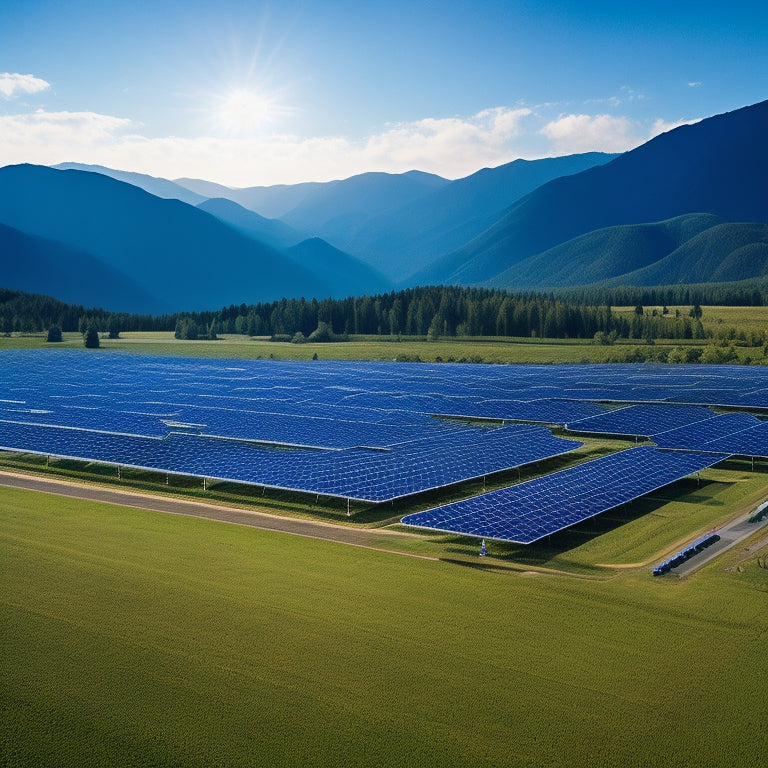
Designing a Commercial Solar Array for Maximum Efficiency
Share
When designing a commercial solar array for maximum efficiency, you'll need to assess site conditions, including topography, soil, and weather patterns. Select high-efficiency solar panels with optimal durability and warranty coverage. Configure the array's orientation and tilt to minimize shading and maximize energy production. Properly size and select inverters to minimize energy losses, and guarantee compliance with electrical codes and regulations. By following these essential steps, you'll be well on your way to creating a highly efficient commercial solar array. Now, take the next step to fine-tune your design and enhance your energy output.
Key Takeaways
- Conduct a thorough site assessment to determine optimal panel orientation, tilt, and layout for maximum energy output.
- Select high-efficiency solar panels with ratings above 20% and consider factors like durability, temperature coefficients, and weather resistance.
- Optimize array orientation and tilt based on local climate and shading patterns, and consider seasonal adjustments for regions with distinct seasonal patterns.
- Ensure proper inverter selection and configuration to minimize energy losses, and consider options like string inverters, central inverters, and power optimizers.
- Implement a monitoring and performance evaluation system to collect real-time data, track energy output, and identify areas for improvement.
Assessing Site Conditions and Constraints
When designing a commercial solar array, analyzing site conditions and constraints is often the first crucial step. You'll need to evaluate the site's topography, contemplating the lay of the land, slope, and elevation. This will help you determine the ideal panel orientation and tilt to maximize energy production.
Next, you'll want to review the environmental impact of your solar array. This includes examining local regulations, zoning restrictions, and land-use agreements to guarantee your project complies with all necessary requirements.
You'll also need to take into account the soil conditions, confirming the ground can support the weight of the panels and mounting structures.
Additionally, you'll need to verify utility access, including the availability of electrical infrastructure and transmission lines. Weather patterns, such as wind loads, snowfall, and extreme temperatures, must also be taken into account to assure your array can withstand local climate conditions.
Selecting High-Efficiency Solar Panels
When selecting high-efficiency solar panels for your commercial array, you'll want to take into account module efficiency ratings, which measure a panel's ability to convert sunlight into electricity.
You'll also need to evaluate panel durability factors, such as temperature coefficients and weather resistance, to guarantee peak performance over the system's lifespan.
Module Efficiency Ratings
Among the myriad factors influencing a commercial solar array's overall performance, module efficiency ratings play an essential role in maximizing energy output.
You need to understand the significance of module efficiency ratings to select high-efficiency solar panels that meet your energy goals. Module efficiency is typically measured as a percentage, with higher ratings indicating better performance.
When evaluating module efficiency, you should consider efficiency benchmarks such as the National Renewable Energy Laboratory's (NREL) efficiency ratings. These benchmarks provide a standardized structure for comparing module performance across different manufacturers.
Look for modules with high efficiency ratings, typically above 20%, to guarantee peak energy output. Additionally, consider the temperature coefficient, which affects module performance under varying environmental conditions.
Panel Durability Factors
Frequently, commercial solar array designers overlook a significant aspect of panel selection: durability. When selecting high-efficiency solar panels, you must consider the durability factors that guarantee ideal performance over the system's lifespan.
Weather resistance is important, as panels are exposed to various environmental conditions. Look for panels with a high IP rating, indicating their ability to withstand water and dust ingress. Material longevity is also essential, as it affects the panel's thermal performance and susceptibility to UV exposure. Mechanical stress, such as wind and snow loads, can also impact panel performance, so confirm the panels you choose can withstand these forces.
Additionally, consider the warranty coverage and maintenance requirements of the panels. A thorough warranty can provide peace of mind, while low maintenance requirements can reduce operational costs.
Optimizing Array Orientation and Tilt
Optimizing Array Orientation and Tilt
Most commercial solar arrays are installed at a fixed tilt and orientation, and optimizing these parameters can greatly impact energy production. You'll want to take into account the local climate, surrounding terrain, and shading patterns to determine the ideal orientation and tilt for your array.
| Season | Optimal Tilt Angle |
|---|---|
| Summer | 10-15° |
| Spring/Fall | 20-25° |
| Winter | 30-35° |
| Year-round (fixed) | 25-30° |
In regions with distinct seasonal patterns, incorporating seasonal adjustments can lead to significant energy gains. Alternatively, you can think about investing in solar tracking systems, which can flexibly adjust the array's orientation and tilt to maximize energy production throughout the day. By optimizing these parameters, you can increase your array's energy output and reduce the levelized cost of energy.
Configuring Module Layout and Strings
You'll need to determine the ideal row spacing for your commercial solar array to guarantee maximum energy production while minimizing land use.
When configuring the module layout, you'll also need to take into account string inverter sizing to enhance the electrical output of each string.
Optimal Row Spacing
When designing a commercial solar array, determining the ideal row spacing is critical to maximizing energy production while minimizing land use and installation costs. You must strike a balance between allowing enough space for maintenance and minimizing land use.
Too little space between rows can lead to shading, reducing sunlight exposure and overall energy production. Conversely, excessive spacing can result in underutilized land and increased installation costs.
To achieve the best row spacing, consider factors such as module size, array orientation, and local climate conditions. For example, if you're designing a solar array in a region with high temperatures and low humidity, you may want to increase row spacing to improve airflow and reduce heat-related energy losses.
Additionally, consider the type of maintenance equipment that will be used, as larger equipment may require more clearance.
String Inverter Sizing
Configuring module layout and strings is an essential step in string inverter sizing, as it directly impacts the overall efficiency and reliability of your commercial solar array. You'll need to determine the ideal string size and configuration to guarantee maximum power output. This involves selecting the appropriate string inverter type, considering factors such as inverter efficiency, maximum power point tracking (MPPT), and monitoring capabilities.
When selecting a string inverter, consider the three main types: central, string, and microinverters. Central inverters are suitable for large-scale installations, while string inverters are ideal for smaller systems. Microinverters, on the other hand, offer maximum flexibility and monitoring capabilities.
Inverter efficiency is a critical factor, as it directly affects the overall system efficiency. Look for inverters with high efficiency ratings (>98%) to minimize energy losses. Additionally, consider the inverter's maximum DC input voltage and current to ascertain compatibility with your module layout and string configuration.
Sizing and Selecting Inverters Correctly
Sizing and Selecting Inverters Correctly
Three key factors influence the sizing and selection of inverters in a commercial solar array: the system's DC power output, the AC power requirements of the grid, and the inverter's efficiency.
You need to take these factors into account to guarantee that your inverter can handle the power output of your solar array and meet the requirements of the grid.
When selecting an inverter, you have several options to choose from, including:
- String inverters, which convert DC power from a string of solar panels to AC power
- Central inverters, which convert DC power from multiple strings of solar panels to AC power
- Microinverters, which convert DC power from individual solar panels to AC power
- Power optimizers, which optimize the DC power output of individual solar panels before converting it to AC power
- Inverter placement options, such as rooftop, ground-mounted, or inverter stations, which can impact inverter performance and maintenance
Ensuring Proper Grounding and Bonding
Two vital safety considerations in commercial solar array design are guaranteeing proper grounding and bonding.
You must verify that your solar array is properly grounded to prevent electrical shock and fire hazards. Proper grounding involves connecting the solar array's electrical components to the earth to dissipate electrical currents. You can achieve this through various grounding techniques, including driven rod grounding, concrete-encased electrode grounding, and grounding mats.
Proper bonding is also important to confirm that all metal components in the solar array are connected to a common grounding point. This prevents the buildup of electrical potential differences between components, reducing the risk of electrical shock and arcing.
You'll need to select suitable bonding materials, such as copper wires or aluminum busbars, to connect metal components. It's important to follow established guidelines, such as those outlined in the National Electric Code (NEC), to guarantee that your grounding and bonding systems meet safety standards.
Meeting Electrical Code Requirements
You'll need to ascertain your commercial solar array design meets electrical code requirements by creating a thorough Code Compliance Checklist and traversing the Electrical Inspection Process.
This checklist will help you identify and address potential code violations, while the inspection process will verify that your installation meets local and national electrical codes.
Code Compliance Checklist
Electrical inspectors scrutinize commercial solar array installations to confirm they meet stringent electrical code requirements, and a thorough code compliance checklist is essential to avoid costly rework and project delays.
You'll need to verify your design meets all relevant electrical codes, including the National Electric Code (NEC) and local ordinances.
To confirm compliance, you should verify the following:
- You have obtained all necessary building permits and approvals before commencing construction
- Your system design meets NEC requirements for electrical safety and performance
- You have secured utility interconnection agreements and approvals from local authorities
- Your installation meets local fire codes and ordinances
- You have provided clear documentation and labeling for all electrical components and systems
Electrical Inspection Process
The commercial solar array design undergoes a thorough electrical inspection process to certify it meets the stringent electrical code requirements. You must verify that your design complies with local and national electrical codes, such as the National Electric Code (NEC) in the United States.
The inspection process involves a series of checks to confirm that your design meets safety protocols and performance standards.
You'll need to create an inspection schedule to identify potential issues before they become major problems. This schedule should include regular checks of the electrical infrastructure, including the inverters, wiring, and connections.
During the inspection, you'll verify that all electrical components are properly installed, labeled, and secured. You'll also check for any signs of wear or damage, certifying that the system operates safely and efficiently.
Managing Shade and Obstruction Losses
Shadows cast by trees, buildings, or other obstructions can greatly reduce your commercial solar array's energy output.
To mitigate these losses, it's crucial to conduct a thorough shade analysis during the design phase. This involves evaluating the sun path and identifying potential obstructions that may impact your array's performance.
To minimize shade and obstruction losses, consider the following strategies:
- Conduct regular tree trimming and greenery management to prevent foliage growth from encroaching on your array
- Optimize building placement and orientation to reduce shading from surrounding structures
- Install shading devices, such as louvers or overhangs, to block direct sunlight during peak hours
- Make seasonal adjustments to your array's tilt and orientation to account for changes in the sun's path
- Implement obstruction mitigation measures, such as relocating or removing obstacles, to guarantee maximum energy output
Implementing Energy Monitoring Systems
With your commercial solar array up and running, it's essential to keep a close eye on its performance to guarantee you're getting the most out of your investment. Implementing an energy monitoring system allows you to collect real-time data on your array's performance, enabling you to identify areas of improvement and optimize energy production.
Energy analytics tools provide significant observations into system performance, enabling performance benchmarking and predictive maintenance. By integrating your monitoring system with your existing infrastructure, you can streamline user engagement and confirm seamless system integration.
Conducting regular cost-effectiveness analysis helps you identify opportunities to reduce energy costs and maximize your return on investment. Furthermore, monitoring your environmental impact allows you to track your carbon footprint and make data-driven decisions to minimize your ecological effect.
Conducting Performance Testing and Validation
Your commercial solar array's performance relies heavily on precise installation and configuration. To guarantee your system is operating at its best, you need to conduct thorough performance testing and validation. This involves developing and executing testing protocols that evaluate your array's performance metrics, such as energy output, efficiency, and reliability.
Some key aspects to focus on during testing and validation include:
- Implementing data analysis techniques to identify trends and areas for improvement
- Establishing efficiency benchmarks to compare your system's performance against industry standards
- Conducting system diagnostics to detect and address any technical issues
- Performing performance comparisons to assess your array's environmental impacts and reliability assessments
- Conducting long-term monitoring to guarantee your system continues to meet its performance expectations over time
Frequently Asked Questions
How Often Should the Solar Array Be Cleaned for Optimal Performance?
You'll want to clean your solar array regularly to minimize performance losses; research suggests cleaning every 6-12 months, as dirt and debris can reduce energy output by up to 25%, impacting your overall energy yield and bottom line.
Can Commercial Solar Arrays Be Installed on Rooftops With Skylights?
You'll need to carefully consider skylight placement and roof structure when installing commercial solar arrays on rooftops, ensuring a secure and efficient setup that maximizes energy output while accommodating existing design features.
Are There Any Tax Incentives for Commercial Solar Array Installations?
You'll be pleased to know that yes, there are tax incentives for commercial solar array installations, including federal tax credits of up to 30% of the total cost and state incentives that vary by location, helping you maximize your investment's ROI.
Can a Solar Array Be Connected to an Existing Electrical System?
You're about to utilize the power of the sun, and now you're wondering if you can connect your solar array to the existing electrical system - a seamless marriage of old and new. Yes, you can integrate your array with the grid, incorporating energy storage for a stable and efficient supply.
Are Commercial Solar Arrays Covered Under Product Warranties?
You'll typically find commercial solar arrays backed by extensive warranties, covering defects and performance issues for 25 years or more, ensuring a lengthy product lifespan and minimizing downtime, with warranty coverage often extending to inverters and other system components.
Conclusion
You've carefully crafted your commercial solar array, and now it's ready to shine like a guiding light of sustainability. With high-efficiency panels, ideal orientation, and expertly configured modules, your system is prepared to maximize energy production. By maneuvering through electrical codes, mitigating shade losses, and implementing monitoring systems, you've guaranteed a seamless and efficient operation. The final piece of the puzzle is performance testing, and with that, your solar array will be a masterpiece of renewable energy, radiating success.
Related Posts
-

Off-Grid Solar Solutions for Sustainable Farming
Off-grid solar solutions can revolutionize your farming operations by providing energy independence and significant c...
-
Trends in Renewable Energy Storage Technologies
You're witnessing rapid advancements in renewable energy storage technologies aimed at improving efficiency and scala...
-

Innovative Sustainable Materials for Energy-Efficient Homes
Innovative sustainable materials enable you to create energy-efficient homes while promoting environmental responsibi...

